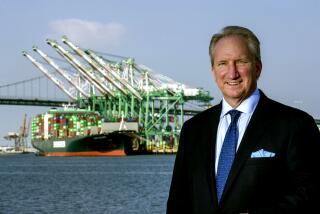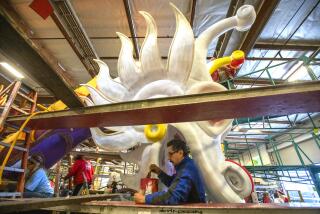Port Cities to Honor 100th Birthday of Harry Bridges
Harry Bridges’ trademark caps, his fighting spirit speeches and--most significant--the staunchly pro-union sentiment he injected into ports from San Diego to Seattle will be on proud display in San Pedro next week.
The legendary labor leader, who built the International Longshoremen and Warehousemen’s Union into a position of supremacy on West Coast docks, has been dead for a decade.
But starting Monday, his memory will be very much alive as the hard-working communities of San Pedro and Wilmington will be hosting a weeklong celebration of the tough, hawk-faced union activist’s 100th birthday.
The commemoration will feature a parade over the Vincent Thomas Bridge led by local elected officials and thousands of longshoremen and their supporters from as far as Japan and South Korea. It will also include museum exhibits, theater events, harbor tours and educational seminars.
Old-timers say the Port of Los Angeles has not seen a peaceful labor event of this scale since the Labor Day marches of the 1930s, when thousands of longshoremen walked through downtown San Pedro in black Frisco jeans, white shirts and white short-brim caps known as Harry Bridges Stetsons.
In the port communities, the name Harry Bridges still conjures up images of longshoremen going out on strike, or battling with police on picket lines. The Australian-born seaman came into prominence in the dockers’ walkout that plunged West Coast ports into a bloody general strike in 1934. After that, the union grew and prospered. Now, the ILWU’s 16,000-member work force includes some of the highest-paid hourly workers in the country.
“He was a fascinating, complex man,” said actor Ian Ruskin, who will portray the union leader Friday night in his one-man play titled “From Wharf Rats to Lords of the Docks” at San Pedro’s old picture palace, the Warner Grand Theater.
“A Marxist who believed the U.S. Constitution was one of the world’s greatest documents. A lifelong fighter for the rank and file who spent 21 years trying to become a U.S. citizen. He also lost half his stomach to ulcers, had three wives, two divorces and enjoyed betting on the horses.”
In a place still strongly associated with blue-collar wharf jobs, the week of events will also present a show of union strength a year before new contract talks begin with terminal operators. The most sensitive issues are expected to include the industry’s desire for new technology that could displace dock workers.
“The message we want to put out is Harry Bridges’ own: The real heroes in America are working-class people,” said David Arian, president of the nonprofit Harry Bridges Institute and a former international president of the ILWU.
The San Pedro-based institute is a nonprofit organization founded in 1993 to educate a new generation about the rich history of labor and the trade union movement. It and the ILWU are sponsoring the week.
“We’re celebrating labor culture: how working gives you an identity, a way of life and a reason to be alive,” Arian said.
Assemblyman Alan Lowenthal (D-Long Beach), who expects to participate in the July 28 bridge parade, said: “These people take their union work very seriously; it’s part of their lives and it permeates the communities that identify with the Port of Los Angeles.”
“They take fierce pride in what they have been able to accomplish,” he added, “for their pensioners, their families and communities for generation upon generation.”
“Harry Bridges 100th Birthday Celebration” posters are already taped on the windows and entrances to many downtown San Pedro shops and restaurants.
Stacking a fresh batch of Harry Bridges Stetsons--identical to the union leader’s trademark headgear--on a shelf inside Cheerful Al’s Union War Surplus store on 6th Street, manager Jeff Daquila explained, “I just ordered a few hundred more of these caps.”
“I have two kinds: American-made and cheaper ones made in Singapore,” he added. “The longshoremen, of course, all want the American-made caps, which go for $8.99.”
A block down the street, Larry Hodgson, owner of San Pedro’s popular Beach City Grill, was selling tickets for Ruskin’s play along with the sizzling specials he was serving to the local lunch crowd.
“To me, the strength and beauty of the union in San Pedro is the cohesiveness it brings to local society,” he said. “It’s one of the reasons people are born here, marry here and stay here.”
The celebration’s events include Tuesday’s opening of an exhibit on Bridges’ life and times at the Los Angeles Maritime Museum. Curator Marifrances Trivelli organized the display of photographs and documents supplied by the union, port officials and local pensioners.
The celebration will culminate in the two-mile parade over the Vincent Thomas Bridge--from Terminal Island to San Pedro--at 10 a.m. July 28.
Bridges immigrated to the United States at the age of 19.
By 1924, he had become a militant labor organizer of the newly organized International Longshoremen’s Assn.
Monument to Slain Longshoremen
The stage was set for a waterfront showdown in 1933 when shippers steadfastly refused to negotiate with the ILA.
At 8 p.m. on May 9, longshoremen and warehousemen from Bellingham to San Diego walked off the job. Employers brought in strikebreakers and used political muscle to force police intervention.
Five longshoremen in San Francisco, Seattle and San Pedro were shot to death, and hundreds of others were injured over the next few days.
A little-known monument marks the spot near the port’s Berth 145 where Dickie Parker of San Pedro and John Knudson of Lomita were shot to death by guards hired by the shipping lines. Pensioners have long complained that the shrine does not mention the names of the slain longshoremen it was built to honor.
The National Guard was called in to stop the violence. Bridges turned down a $50,000 bribe to back off from the dockers’ demand for a hiring hall. Then-ILA President Joe Ryan negotiated a closed-door deal with the shipping bosses, which was rejected by the strikers led by Bridges.
Bridges and other ILA members won support from unions up and down the coast for a general strike in San Francisco that lasted four days but shifted the balance of power. Longshoremen won a coast-wide agreement, a union hiring hall, shorter hours, safer conditions and increased pay.
The ILA broke apart as the ILWU took shape under Bridges’ leadership.
In 1936, the federal government made the first of three efforts to deport Bridges, who had been labeled a Red, as an undesirable alien. Efforts to deport him ended in 1955 after a federal district judge ruled that the government failed to prove he was a Communist or that he concealed the fact when he was naturalized in 1945. However, historians today continue to debate the true extent of Bridges’ ties to the Communist Party.
Bridges, who was proud to be among the lowest-paid union bosses in the nation, calculated his income based on the average earnings of a longshore worker, a warehouse worker and a pineapple/sugar plantation worker.
George Kuvakas, president of the ILWU’s pensioners group, recalled that Bridges seemed almost obsessed with not being elitist.
Sitting on a large granite rock beside a building that used to house a city jail that was all too familiar with union organizers in the 1930s, Kuvakas recalled, “When he retired in 1977, I was told to have a limousine put on 24-hour call at his house.”
“It was supposed to have been a special courtesy for a great man,” said Kuvakas, who will be giving a talk during the celebration. “But he said, ‘Keep it. I’ll use my car.’ ”
The day after Bridges died of emphysema on March 30, 1990, 9,000 union members along the coast walked off the job.
Not all of the San Pedro celebrants will have union cards. Take the five Rosales sisters--ages 21, 20, 17, 15 and 11--who plan to join the parade.
“I’ll be working for the union just as soon as I can get an application filed,” said Ester Rosales, 21, a film major at Cal State Monterey Bay who has been volunteering at the Harry Bridges Institute since she was 16. “It’s hard, honest work--driving trucks, operating cranes--and it has to be done.”
Hammerhead crane operator Greg Mitre, whose wife also is a union crane worker, could not agree more. Deftly removing 25-ton containers from a huge ship by flipping a toggle switch in the cramped cab of his 100-foot-tall crane, he said, “I move 35 containers an hour, 300 a day.”
The Honolulu ship below had arrived laden with 220 automobiles, 100 head of cattle and 900 containers full of pineapples, sugar, coffee and fresh flowers. Shouting to be heard over a din of industrial noise, Mitre said he intended to join the parade honoring Bridges.
“Harry was instrumental in agreements that led to these container ships coming into port, and look at us now,” he said.
“We’ve perfected our work; we’re good at it. There is not one piece of cargo in this entire port that isn’t moved by longshoremen. Hey, I’m a cog in a great big wheel, and I love it.”
San Pedro Events
Among the San Pedro events are:
* Free historic walks led by union old-timers at 11 a.m. and 12:30 p.m. and harbor boat tours at noon and 1:30 p.m. Tuesday and Wednesday, all starting from the Maritime Museum at the corner of 6th Street and Harbor Boulevard.
* “Bread and Roses,” a film about the struggles of Los Angeles janitors, 7 p.m. Thursday at the Warner Grand Theater, 478 W. 6th St.
* The play “From Wharf Rats to Lords of the Docks,” 7:30 p.m. Friday at the Warner Grand.
More information is available at (310) 831-2397 or https://www.harrybridges.com.
More to Read
Sign up for Essential California
The most important California stories and recommendations in your inbox every morning.
You may occasionally receive promotional content from the Los Angeles Times.











